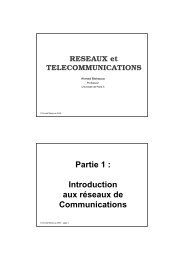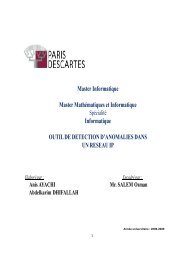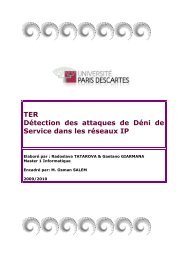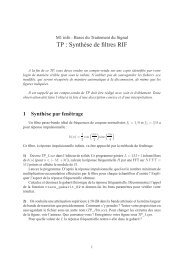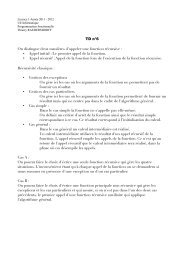Th`ese de Doctorat de l'université Paris VI Pierre et Marie Curie Mlle ...
Th`ese de Doctorat de l'université Paris VI Pierre et Marie Curie Mlle ...
Th`ese de Doctorat de l'université Paris VI Pierre et Marie Curie Mlle ...
You also want an ePaper? Increase the reach of your titles
YUMPU automatically turns print PDFs into web optimized ePapers that Google loves.
in the literature to predict the near-term transmission rate of a connection based on<br />
past traffic measurements; however, the focus of this thesis is not to find out the best<br />
traffic predictor.<br />
In this work we only rely on the last measured value, b n−1<br />
k , and we propose the fol-<br />
lowing simple bandwidth allocation: rn k =min{2·bn−1 k ,srk}, ∀k ∈ Kng. In this regard<br />
we are currently studying more efficient traffic predictors that can allow improved<br />
bandwidth allocation. We study the impact of this choice in Chapter 8, through the<br />
performance of the mathematical mo<strong>de</strong>l.<br />
• Greedy connections are assigned in this step their subscribed rate srk, and they<br />
Step 2<br />
further take part to the allocation of extra-bandwidth performed in Step 2, since<br />
they are already exploiting all their subscribed rate.<br />
After having performed the allocations <strong>de</strong>scribed in Step 1, each algorithm individuates on<br />
each link l the residual bandwidth Rl, i.e. the spare bandwidth as well as the bandwidth left<br />
unused by idle and non-greedy connections. Rl is hence given by the following expression:<br />
Rl = Cl − ( <br />
k∈Ki∪Kng<br />
r n k · a l k + <br />
srk · a l k ), ∀l ∈ L (5.1)<br />
where the first summation represents the total bandwidth allocated in Step 1 to idle and<br />
non-greedy connections, while the second summation represents the bandwidth allocated<br />
to greedy connections. Such extra-bandwidth is distributed exclusively to greedy users<br />
k∈Kg<br />
who can exploit it to transmit at a rate higher than their subscribed rate.<br />
To this aim, we propose in the following three heuristics for the bandwidth alloca-<br />
tion problem and in the next Chapter, we further illustrate a mathematical mo<strong>de</strong>l which<br />
provi<strong>de</strong>s an upper bound to the n<strong>et</strong>work revenue that can be obtained by any dynamic<br />
bandwidth allocation scheme.<br />
43



